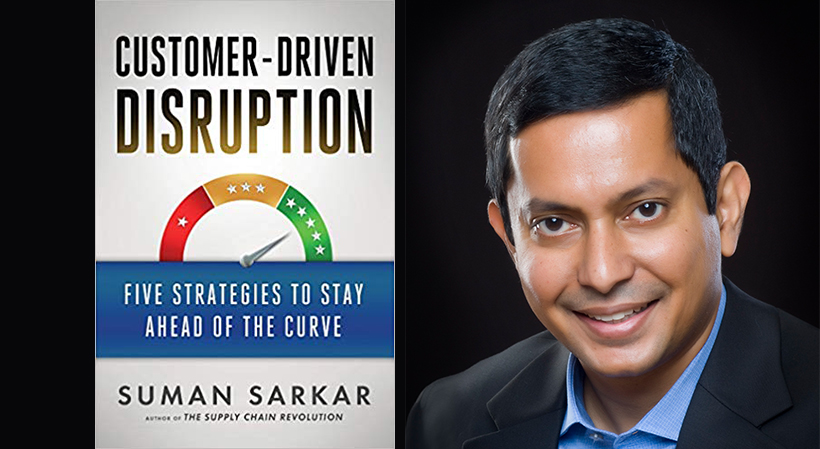The following is excerpted from “Customer-Driven Disruption: Five Strategies To Stay Ahead of the Curve” by Suman Sarkar. Published by Berrett-Koehler. Copyright (c) 2019. All rights reserved. This book is available at all bookstores and online booksellers.
Far too often, leaders focus on technology as the driving force of business disruption, but the truth is that new customer needs and expectations are what is shaking up your business. This article focuses on one of the most important and trickier disruptive trends: personalization, the notion of creating products or services that are tailored to each individual. The key to turning this trend into a business opportunity is finding a way to make personalization affordable.
Personalization challenges all the fundamental concepts business leaders were taught from the day they started their career—concepts like “bigger is better” and “standardization.” These concepts date from the Industrial Revolution, when companies didn’t offer customers many choices, but customers bought the mass-produced products anyway because they were so inexpensive.
Special offer: Get the essentials to deliver great customer support, fast — for just $25 a month
That was then. Now, customers everywhere want personalized products and services, and they want them at affordable prices. Even companies beloved by their customers struggle with this.
For example, although millennials love Starbucks and can’t seem to resist a personalized cup of coffee with service, Starbucks’s transactions haven’t increased.
That much is public knowledge, as are the company’s repeated price increases. Starbucks’s same-store sales growth has been steadily declining. Same-store growth from transactions was reduced from 5 percent in 2013 to −1 percent in 2018, whereas value growth stayed between 2 percent and 4 percent. Thus, growth in the United States probably comes from current customers spending more, not more customers coming into the stores.
The larger lesson here: personalization has to be affordable to attract customers.
The younger generations, millennials in particular, want personalized products and services but won’t pay premium prices for them. Thus, affordability is key for all companies now.
Personalization is inherently expensive, but it can be made affordable by thinking outside the box about how to design, create, manufacture and deliver products and services. A few companies are experimenting with personalization, but no one is doing it on a large scale. It’s a big opportunity and a threat to all businesses.
The first to figure out how to produce affordable personalized products will gain huge competitive advantages. To make personalization affordable, leaders will have to think completely differently, create flexible operations and reduce waste.
If you’re wondering whether you need to personalize, consider the following questions:
- How adept is your company at addressing customer needs rather than merely selling products or services?
- How personalized are your company’s products or services?
- How affordable are your personalized offerings?
The degree to which you are doing any of these things is the degree to which your company is set up to sell to newer generations.
Once millennials and Gen Z start dominating spending (and that will happen within the next five to 10 years) everyone, like it or not, will be operating in a new world, with new rules, and personalization is one of them. Your company will either figure out how to personalize or it will wither away.
Related: Navigating Personalization and the Quest for Individuality
Early attempts at personalization
The trend toward personalization started with websites. As customers searching sites grew frustrated at all the irrelevant information, tech companies figured out how to show only relevant content.
E-commerce sites took that a step further by recommending new items based on previous purchases—though many early attempts were (and still are) clumsy and annoying. No one likes to be shown a new laptop just after buying one!
Sephora, a cosmetics store, found a novel way to use customer data. They began recommending products based on the shopper’s skin tone.
In the past, women often found cosmetics that matched their coloring by trial and error. Sephora alone had 110 shades and finding the right one took a lot of effort and time on the part of the salesperson and customer.
But Sephora customers could create profiles, and with those, Sephora could quickly and easily match products to each shopper. Customers loved the personalized recommendations. While the rest of the retail cosmetics industry declines, Sephora continues to grow.
Other companies are figuring out how to recommend clothes, furniture, and many other items.
For example, Stitch Fix and Nordstrom Trunk provide online personal assistant services that could recommend clothes and send a box of them based on customer preference and style.
All the customer has to do is complete an interactive questionnaire comparing different styles, and with that, the company learns what the customer likes.
Other ways in which companies are personalizing products include more fun packaging and labeling.
To celebrate its 50th anniversary in the United Kingdom, Heinz (whose beans are very popular there) gave customers the option of putting their names on the beans can.
Similarly, sneaker companies such as Nike and Adidas are providing limited customization by allowing customers to choose shoes’ color, type and logo size.
However, these efforts are nowhere near the personalization the new generations want. Recommending existing products or services based on customer data are not personalization.
Personalization means creating unique products or solutions based on an individual’s wishes. True personalization wouldn’t be choosing your sneaker color; it would be sneakers made just for you. The sneakers would be shaped precisely for your foot measurements, arch height, and even how you walk or run. So, we are a long way from real personalization.
Sign Up: Receive the StartupNation newsletter!
Making affordable personalization a reality
Personalization is a 180-degree change for most corporations. They are all tuned for mass production and would rather sit out the personalization fad. But new generations have made the fad a permanent reality. You either choose to play or go home.
With Sephora and others, we see very initial efforts at personalization. They are matching personal customer information with products that fit customer preference.
Vistaprint and Shutterfly are making personalized photo albums, enabling users to design their own photo albums with a variety of layouts, fonts and colors. Squarespace is doing the same for websites, offering hundreds of different templates for customized looks.
Services like these cost a fraction of what a graphic designer would charge. More and more retailers are providing personal stylist services, if users are willing to share their personal preferences. However, we are still a long way from real personalization.
The challenges with personalization stem primarily from the costs associated with providing these services.
To make personalization a reality, companies will have to think differently. They have to think from a customer’s perspective instead of beginning from their products and services.
Affordability is key—and the benefits to both companies and their customers could literally be life-changing.
And in any industry, companies that don’t offer their customers personalized products and services at affordable prices will lose out to companies that do. As millennials and Gen Z become the dominant buying group, the demand for personalized services will increase significantly.
This is both an opportunity and a threat. It’s a threat because none of today’s dominant companies have invested significantly in personalization and are still running on old paradigms. But it’s an opportunity because no one knows who the winners will be.
Whoever they are—startups or established companies thinking outside the box and unafraid to start over—they will be the next Apples or Amazons, companies that will dominate for a long time.
Personalized services are sticky; once customers find a company that gives them exactly what they want, personalized just for them, they keep coming back.
“Customer-Driven Disruption: Five Strategies To Stay Ahead of the Curve” is available now and can be purchased via StartupNation.com.






